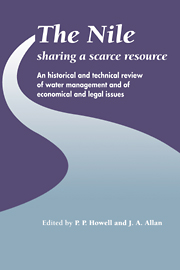 The Nile: Sharing a Scarce Resource
The Nile: Sharing a Scarce Resource Book contents
- Frontmatter
- Contents
- Preface
- List of Contributors
- Orthography
- Units and Conversion Factors
- Introduction
- I Environmental history of the Nile and its management
- 1 Origin and evolution of the Nile
- 2 History of Nile Flows
- 3 History of water use in the Sudan and Egypt
- 4 East Africa's water requirements: the Equatorial Nile Project and the Nile Waters Agreement of 1929. A brief historical review
- 5 History, hydropolitics and the Nile: Myth or reality
- II Nile management and factors affecting future management
- III Future utilisation of Nile waters
- IV Economic, international and legal issues
- Index
2 - History of Nile Flows
Published online by Cambridge University Press: 05 February 2012
- Frontmatter
- Contents
- Preface
- List of Contributors
- Orthography
- Units and Conversion Factors
- Introduction
- I Environmental history of the Nile and its management
- 1 Origin and evolution of the Nile
- 2 History of Nile Flows
- 3 History of water use in the Sudan and Egypt
- 4 East Africa's water requirements: the Equatorial Nile Project and the Nile Waters Agreement of 1929. A brief historical review
- 5 History, hydropolitics and the Nile: Myth or reality
- II Nile management and factors affecting future management
- III Future utilisation of Nile waters
- IV Economic, international and legal issues
- Index
Summary
Introduction
The drought which has ravaged most Sahelian countries during the 1970 and 1980 decades is unprecedented in recent records. The objective of this chapter is to compare the recent sequence of low Nile floods with past historical evidence of droughts in Egypt; an attempt to put this century's flows in an historical context.
The major question facing engineers, planners and politicians alike is whether this drought will continue; whether this persistence of low rainfall years in the Sahel is just further evidence of the natural ‘Hurst Phenomena’, whereby sequences of low Nile flows and large Nile floods tend to occur together, or whether it is man-made, possibly a manifestation of global warming representing a permanent or semi-permanent change in the general circulation of the atmosphere influencing the continental climate of Africa.
The Sahel is a region with steep rainfall gradients with annual rainfall decreasing rapidly from 600 mm to less than 200 mm in a few hundred kilometres. Slight shifts in the circulation can cause major problems which would go unnoticed in other climatic zones.
The Nile is the birth place of hydrology. No other river provides such a wealth of information. Available records reach back to before 3000 BC. The heavy dependence of Egyptian civilisation on the size of Nile floods, leading to years of famine or plenty, and the ability of Egyptian dynastic society to record evidence for posterity provides a unique opportunity to investigate historical river flows.
- Type
- Chapter
- Information
- The Nile: Sharing a Scarce ResourceA Historical and Technical Review of Water Management and of Economical and Legal Issues, pp. 27 - 64Publisher: Cambridge University PressPrint publication year: 1994
- 12
- Cited by


